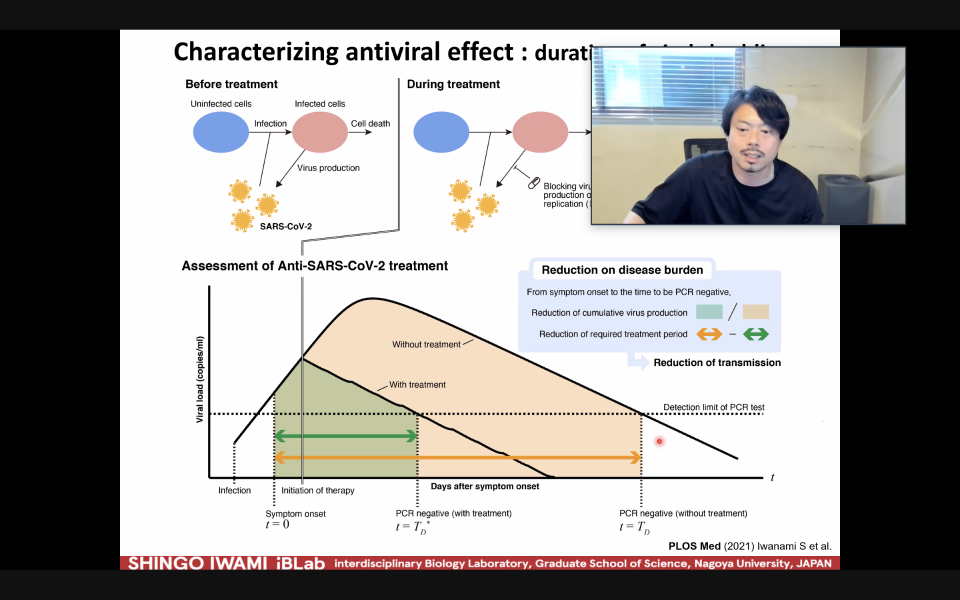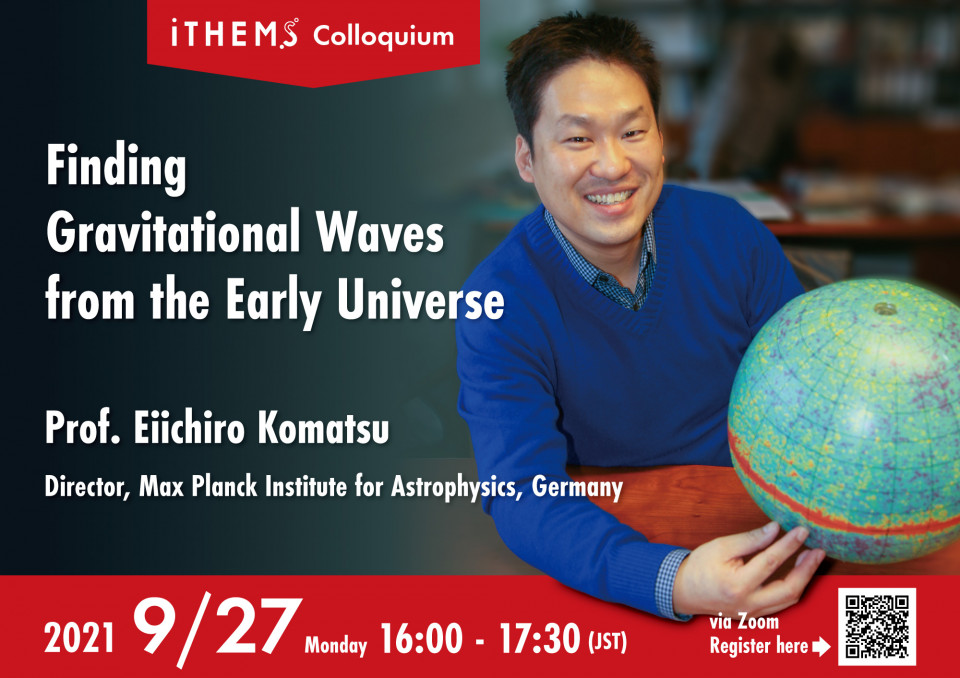Volume 159
Back to Newsletter List
Seminar Report
iTHEMS Colloquium by Prof. Shingo Iwami on July 8, 2021
2021-07-12
In his presentation for the iTHEMS Colloquium, Prof. Shingo Iwami discussed the foundational approach of his research: using a mathematical model-based approach to link experimental data from ever-improving experimental measurement technology in order to tackle problems in Biology, particularly in hematology, infectious diseases, cancer, etc. He illustrated his research approach through several examples that ranged from HIV, Hepatitis C virus, and the new SARS corona virus (SARS-CoV-2). He highlighted some of the key challenges that are faced when trying to extract specific information from limited data, and how properly calibrated models can be used to simulate experiments that cannot be performed. He also talked about his plans for the future, and introduced the research team he newly formed at Nagoya University, the interdisciplinary Biology Laboratory or iBLab.
Reported by Catherine Beauchemin
Quantitative Population Dynamics in Interdisciplinary Biology
July 8 (Thu) 10:30 - 12:00, 2021
Upcoming Events
Seminar
Information Theory Seminar
Overview of Tensor Networks in Machine Learning
July 28 (Wed) 13:30 - 14:50, 2021
Qibin Zhao (Team Leader, Tensor Learning Team, RIKEN Center for Advanced Intelligence Project (AIP))
Tensor Networks (TNs) are factorizations of high dimensional tensors into networks of many low-dimensional tensors, which have been studied in quantum physics, high-performance computing, and applied mathematics. In recent years, TNs have been increasingly investigated and applied to machine learning and signal processing, due to its significant advances in handling large-scale and high-dimensional problems, model compression in deep neural networks, and efficient computations for learning algorithms. This talk aims to present a broad overview of recent progress of TNs technology applied to machine learning from perspectives of basic principle and algorithms, novel approaches in unsupervised learning, tensor completion, multi-task, multi-model learning and various applications in DNN, CNN, RNN and etc. We also discuss the future research directions and new trend in this area.
Venue: via Zoom
Event Official Language: English
Seminar
iTHEMS Math Seminar
From Yang-Mills theory to enumerative geometry on Calabi-Yau 4-folds
August 6 (Fri) 16:00 - 18:10, 2021
Yalong Cao (Research Scientist, RIKEN Interdisciplinary Theoretical and Mathematical Sciences Program (iTHEMS))
Yang-Mills theory was studied from mathematical perspectives in the 1970s by Atiyah and his collaborators (notably Drinfeld, Hitchin, Singer). Subsequent breakthroughs were made on dimensions 3 and 4 by Floer and Donaldson (based on deep analytic results obtained by Uhlenbeck and Taubes) in the 1980s. In 1996, Donaldson and Thomas proposed to study Yang-Mills theories on dimensions bigger than 4. In higher dimensions, the analytic method is limited and algebro-geometric method is heavily used instead. This powerful tool usually enables us to compute partition functions and lead to amazing links to other invariants in enumerative geometry, e.g. Gromov-Witten and Gopakumar-Vafa invariants. In this talk, I will review some of these inspiring stories and discuss how my works on Calabi-Yau 4-folds fit into them.
Venue: via Zoom
Event Official Language: English
Colloquium
iTHEMS Colloquium
Finding Gravitational Waves from the Early Universe
September 27 (Mon) 16:00 - 17:30, 2021
Eiichiro Komatsu (Director, Max Planck Institute for Astrophysics, Germany)
The Cosmic Microwave Background (CMB) gives a photographic image of the Universe when it was still an “infant”. We have been using it to test our ideas about the origin of the Universe. The CMB research told us a remarkable story: the structure we see in our Universe such as galaxies, stars, planets, and eventually ourselves originated from tiny quantum fluctuations in the period of the early Universe called cosmic inflation. While we have accumulated strong evidence for this picture, the extraordinary claim requires extraordinary evidence. The last prediction of inflation that is yet to be confirmed is the existence of primordial gravitational waves whose wavelength can be as big as billions of light years. To this end we have proposed to JAXA a new satellite mission called LiteBIRD, whose primary scientific goal is to find signatures of gravitational waves in the polarisation of the CMB. In this presentation we describe physics of gravitational waves from inflation, and the LiteBIRD proposal.
Venue: via Zoom
Event Official Language: English
Paper of the Week
Week 3, July 2021
2021-07-15
Title: A mathematical model of network elastoplasticity
Author: Hiroki Kodama, Ken'ichi Yoshida
arXiv: http://arxiv.org/abs/2107.04310v1
Title: On regular $^*$-algebras of bounded linear operators: A new approach towards a theory of noncommutative Boolean algebras
Author: Michiya Mori
arXiv: http://arxiv.org/abs/2107.05806v1
If you would like to cancel your subscription or change your email address,
please let us know via our contact form.
Copyright © iTHEMS, RIKEN. All rights reserved.





